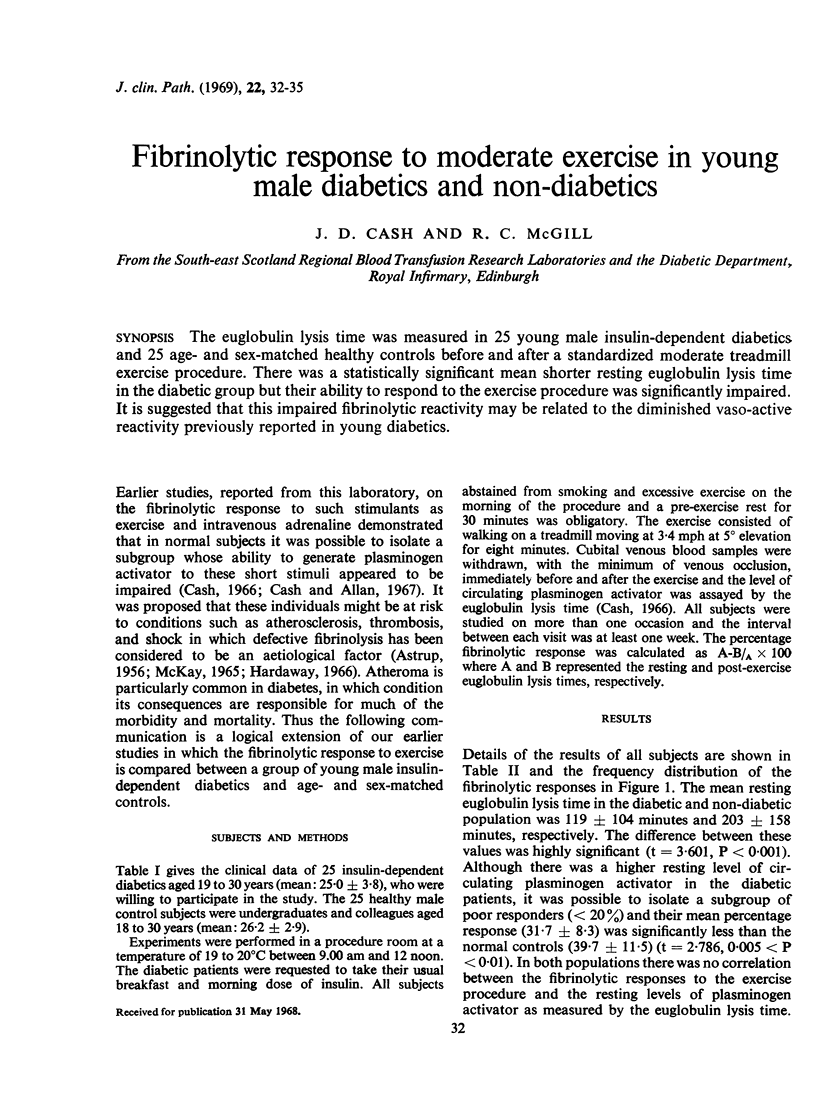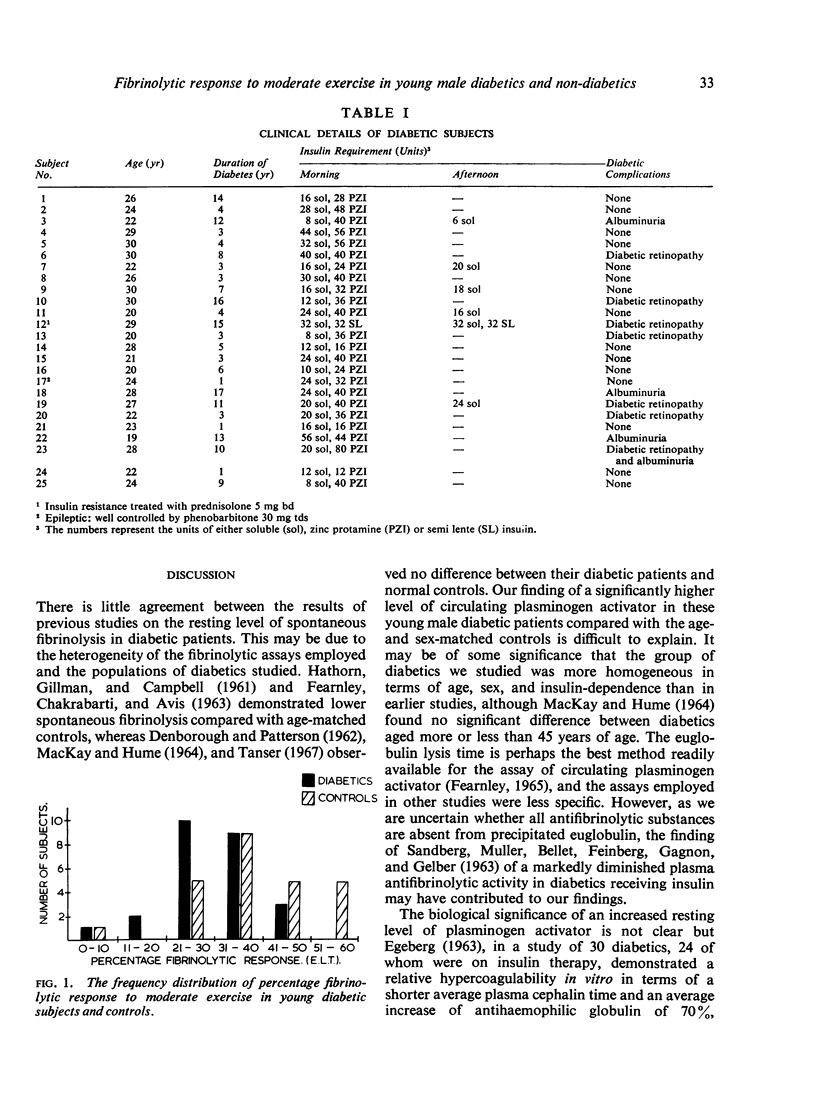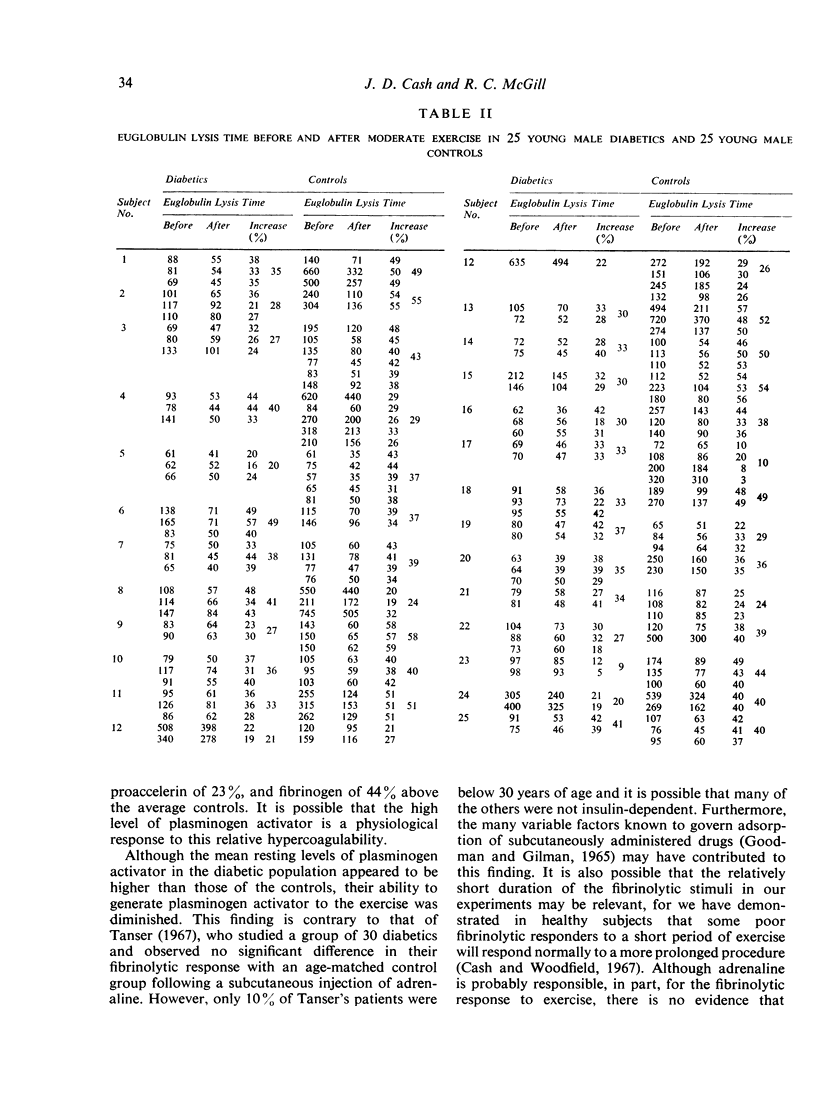Abstract
The euglobulin lysis time was measured in 25 young male insulin-dependent diabetics and 25 age- and sex-matched healthy controls before and after a standardized moderate treadmill exercise procedure. There was a statistically significant mean shorter resting euglobulin lysis time in the diabetic group but their ability to respond to the exercise procedure was significantly impaired. It is suggested that this impaired fibrinolytic reactivity may be related to the diminished vaso-active reactivity previously reported in young diabetics.
Full text
PDF



Selected References
These references are in PubMed. This may not be the complete list of references from this article.
- ASTRUP T. The biological significance of fibrinolysis. Lancet. 1956 Sep 15;271(6942):565–568. doi: 10.1016/s0140-6736(56)92048-7. [DOI] [PubMed] [Google Scholar]
- Cash J. D. Effect of moderate exercise on the fibrinolytic system in normal young men and women. Br Med J. 1966 Aug 27;2(5512):502–506. doi: 10.1136/bmj.2.5512.502. [DOI] [PMC free article] [PubMed] [Google Scholar]
- Cash J. D., Woodfield D. G. Fibrinolytic response to moderate, exhaustive and prolonged exercise in normal subjects. Nature. 1967 Aug 5;215(5101):628–629. doi: 10.1038/215628a0. [DOI] [PubMed] [Google Scholar]
- DENBOROUGH M. A., PATERSON B. Clearing factor, fibrinolysis and blood lipids in diabetes mellitus. Clin Sci. 1962 Dec;23:485–488. [PubMed] [Google Scholar]
- EGEBERG O. THE BLOOD COAGULABILITY IN DIABETIC PATIENTS. Scand J Clin Lab Invest. 1963;15:533–538. [PubMed] [Google Scholar]
- FEARNLEY G. R., CHAKRABARTI R., AVIS P. R. Blood fibrinolytic activity in diabetes mellitus and its bearing on ischaemic heart disease and obesity. Br Med J. 1963 Apr 6;1(5335):921–923. doi: 10.1136/bmj.1.5335.921. [DOI] [PMC free article] [PubMed] [Google Scholar]
- HATHORN M., GILLMAN T., CAMPBELL G. D. Blood lipids, mucoproteins, and fibrinolytic activity in diabetic Indians and Africans in Natal. Possible relation to vascular complications. Lancet. 1961 Jun 17;1(7190):1314–1318. doi: 10.1016/s0140-6736(61)90239-2. [DOI] [PubMed] [Google Scholar]
- HOLEMANS R. ENHANCEMENT OF FIBRINOLYSIS IN THE DOG BY INJECTION OF VASOACTIVE DRUGS. Am J Physiol. 1965 Mar;208:511–520. doi: 10.1152/ajplegacy.1965.208.3.511. [DOI] [PubMed] [Google Scholar]
- LARSSON Y., PERSSON B., STERKY G., THOREN C. EFFECT OF EXERCISE ON BLOOD-LIPIDS IN JUVENILE DIABETES. Lancet. 1964 Feb 15;1(7329):350–355. doi: 10.1016/s0140-6736(64)92098-7. [DOI] [PubMed] [Google Scholar]
- MACKAY N., HUME R. FIBRINOLYTIC ACTIVITY IN DIABETES MELLITUS. Scott Med J. 1964 Sep;9:359–364. doi: 10.1177/003693306400900901. [DOI] [PubMed] [Google Scholar]
- SANDBERG H., MULLER O., BELLET S., FEINBERG L. J., GAGNON F., GELBER L. Alterations in fibrinolytic parameters of subjects with diabetes mellitus. Am J Med Sci. 1963 Feb;245:153–159. [PubMed] [Google Scholar]
- TODD A. S. The histological localisation of fibrinolysin activator. J Pathol Bacteriol. 1959 Jul;78:281–283. doi: 10.1002/path.1700780131. [DOI] [PubMed] [Google Scholar]
- Tanser A. R. Fibrinolytic response of diabetics and non-diabetics to adrenaline. J Clin Pathol. 1967 May;20(3):231–233. doi: 10.1136/jcp.20.3.231. [DOI] [PMC free article] [PubMed] [Google Scholar]


